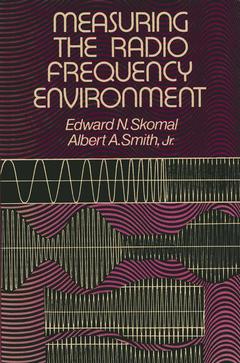Description
Measuring the Radio Frequency Environment, Softcover reprint of the original 1st ed. 1985
Author: Skomal Edward N.
Language: English
Approximative price 52.74 €
In Print (Delivery period: 15 days).
Add to cart
Publication date: 03-2012
368 p. · 15.2x22.9 cm · Paperback
368 p. · 15.2x22.9 cm · Paperback
Description
/li>Contents
/li>
The radio-frequency environment has an obvious and direct influence on the performance of electronic systems that depend upon the transfer of energy through space for their operation. Examples of such systems include radio communications, radio navigation, radar, and commercial AM, FM, and television broadcast systems. Less obvious, but nonetheless significant, is the influence the radio-frequency environment can have on electronic systems that ostensibly do not depend on the transfer of energy through space, for example, the degradation caused by electromagnetic fields generated by citizens band radios, radars, lightning, power lines, and electrostatic discharges on the performance of computers, process control equipments, automotive elec tronics and biomedical instrumentation. The beneficial and deleterious effects of man-made and naturally occurring electromagnetic fields on biological systems, including human beings, although little understood at present, may have more important long-term consequences than upon in the operation of equipment. As the radio-frequency environment evolves with the progression of the electronic age, the necessity to monitor, measure, and characterize it assumes greater importance. The purpose of this book is to provide, in a single self contained volume, the necessary background and methodology needed to execute a survey of the RF environment. We have included representative data on natural and man-made ambients in a variety of settings, wave propagation fundamentals, instrumentation descriptions, survey procedures, and data ana lysis techniques. Much experimental effort has been expended during this century to es tablish an adequate body of knowledge on the radio-frequency environment.
1 Radio Frequency Measurements.- Fundamental Relationships: System Noise Factor.- 2 The Radio Frequency Environment.- Surface Electromagnetic Ambients.- Airborne Electromagnetic Ambients.- Satellite Electromagnetic Ambients.- References.- 3 Radio Propagation Fundamentals.- Propagation Processes Encountered in Radio Frequency Surveys.- Expressions for and Representation of Radio Propagation Processes.- References.- 4 Survey Planning.- Measurement Objectives and Procedures.- Site Evaluation and Selection.- Data Set Dimensions.- Test Duration Planning.- Measurement Risk Assessment in Power Density Surveying.- References.- 5 Characterization of Specialized Test Sites.- Electromagnetic Measuring Sites.- Measurements.- References.- 6 Antennas.- Antenna Parameters.- Relationships between Antenna Parameters.- Types of Receiving Antennas.- Antenna Calibration.- References.- 7 Receiving Equipment.- Receiving System.- Detector Functions.- Calibration of the Receiving System Predetection Circuit.- Detector Calibration.- Computer Support.- References.- 8 Survey Execution.- Documentation.- General Procedures of Surveying.- Power Distribution System Surveys.- References.- 9 Data Analysis Techniques.- Statistical Data Functions.- Sampling Quantization Error.- Least Squares Curve Fitting to Measured Data.- Correlation.- Signal Signature Correlation Measure.- References.- Glossary of Symbols.
© 2024 LAVOISIER S.A.S.




